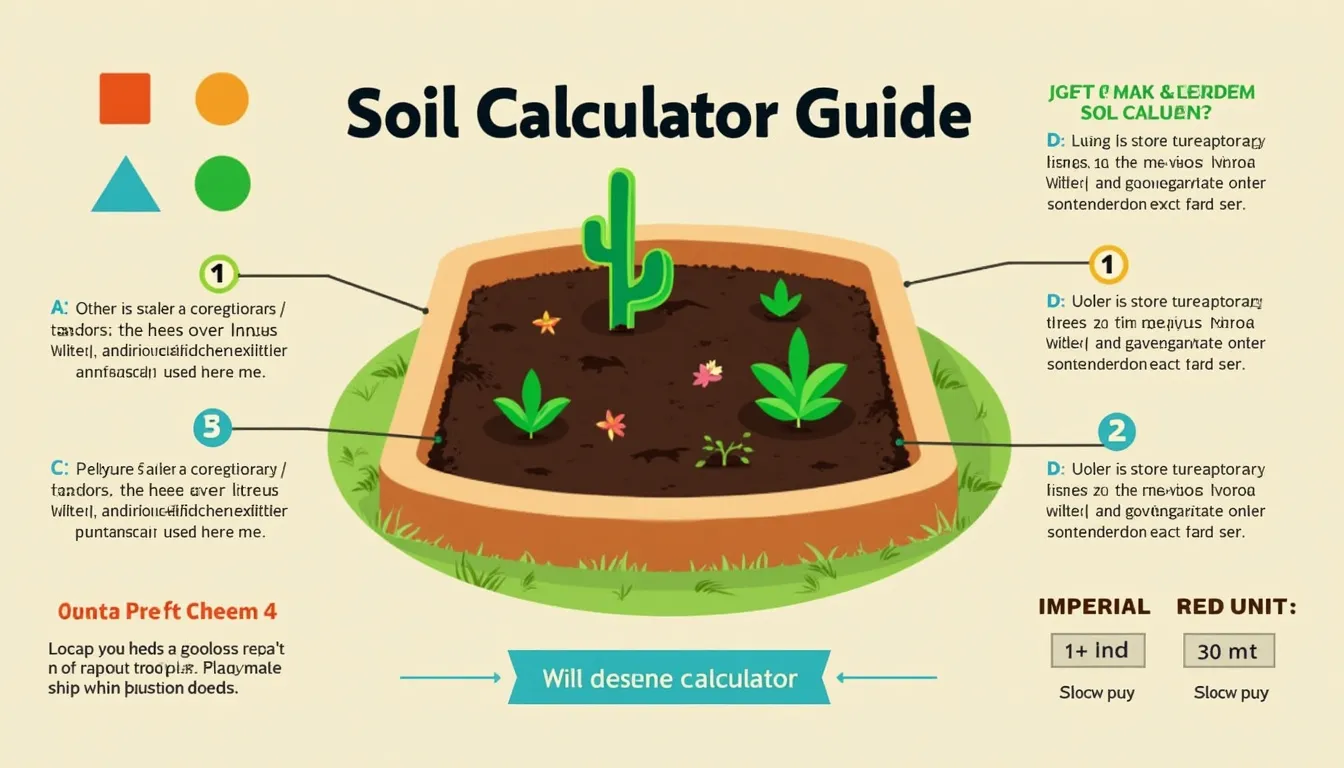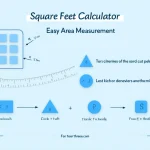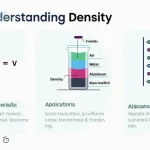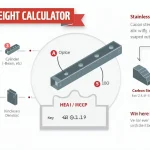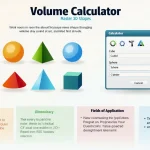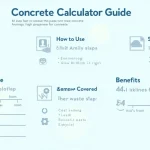Soil Calculator
Is this tool helpful?
How to Use the Soil Calculator Effectively
This versatile soil calculator is designed to help you quickly estimate the volume and weight of soil needed for landscaping, gardening, or agricultural projects. Follow these simple steps to make full use of the tool:
1. Select Your Preferred Unit System
Choose between:
- Imperial: Measurements in feet and pounds; perfect for projects in the United States or countries using imperial units.
- Metric: Measurements in meters and kilograms; ideal for international users or metric system preference.
2. Choose the Shape of Your Project Area
Select the geometric shape that best fits your landscaping area:
- Rectangle: For rectangular garden beds, raised planters, or lawn patches (e.g., length: 12 ft, width: 7 ft).
- Circle: For circular flower beds or round planting zones (e.g., radius: 4 ft).
- Triangle: Perfect for triangular or irregular corner beds (e.g., base: 10 ft, height: 5 ft).
3. Enter Required Dimensions
Input the dimensions according to the shape selected. Here are sample inputs different from the defaults:
- Rectangle: Length: 12 feet, Width: 7 feet
- Circle: Radius: 4 feet
- Triangle: Base: 10 feet, Height: 5 feet
4. Specify Soil Depth
Provide the depth of the soil layer needed for the project. For example, enter 1.2 feet for a garden bed or 35 centimeters in metric.
5. Provide Bulk Density (Optional)
If you know the soil’s bulk density (weight per unit volume), enter the value here to calculate weight more precisely. Common soil bulk density ranges from 1.1 to 1.7 g/cm³. For example, you could enter 1.4. If left blank, a default value of 1.3 g/cm³ is used.
6. Calculate and Review Your Results
After filling in all required fields, click the “Calculate” button. The soil calculator will instantly display:
- Volume: The total soil volume required, displayed in cubic feet or cubic meters according to your chosen unit system.
- Weight: Estimated soil weight based on volume and bulk density, shown in pounds or kilograms.
Introduction to the Soil Calculator: Definition, Purpose, and Benefits
The soil calculator is an essential digital tool tailored for gardeners, landscapers, agricultural professionals, and construction experts alike. It streamlines the process of estimating how much soil is required for various projects, ensuring accurate planning when it comes to volume and weight. By considering unit systems, project area shapes, soil depth, and optional bulk density, it delivers precise results that help optimize material ordering, budgeting, and logistics.
Benefits of using this soil calculator include:
- Accurate soil volume and weight estimates tailored to your specific project dimensions and measurement preferences.
- Flexibility across different area shapes, including rectangles, circles, and triangles.
- Easy-to-use interface suitable for both beginners and professionals.
- Time and cost savings through precise calculations that prevent overordering or shortages.
- Support for bulk density input, enabling realistic soil weight calculations critical for transportation and structural planning.
Example Calculations Using the Soil Calculator
To illustrate, here are practical examples with sample inputs that demonstrate how the calculator determines soil volume and weight.
Example 1: Rectangular Garden Bed
Imagine a raised garden bed measuring 12 feet long, 7 feet wide, with a soil depth of 1.2 feet. Using a bulk density of 1.4 g/cm³ (approximately 87.3 lb/ft³):
$$ \text{Volume} = \text{Length} \times \text{Width} \times \text{Depth} \\ \text{Volume} = 12 \, \text{ft} \times 7 \, \text{ft} \times 1.2 \, \text{ft} = 100.8 \, \text{cubic feet} $$$$ \text{Weight} = \text{Volume} \times \text{Bulk Density} \\ \text{Weight} = 100.8 \, \text{ft}^3 \times 87.3 \, \text{lb/ft}^3 = 8,799 \, \text{pounds} $$Example 2: Circular Flower Bed
For a circular garden space with a radius of 4 feet and a soil depth of 0.8 feet, using the same bulk density:
$$ \text{Volume} = \pi \times \text{Radius}^2 \times \text{Depth} \\ \text{Volume} = 3.14159 \times (4 \, \text{ft})^2 \times 0.8 \, \text{ft} \approx 40.21 \, \text{cubic feet} $$$$ \text{Weight} = 40.21 \, \text{ft}^3 \times 87.3 \, \text{lb/ft}^3 \approx 3,512 \, \text{pounds} $$Example 3: Triangular Planting Area
For a triangular bed with base 10 feet, height 5 feet, and soil depth 1 foot, with bulk density 1.3 g/cm³ (~81 lb/ft³):
$$ \text{Volume} = \frac{1}{2} \times \text{Base} \times \text{Height} \times \text{Depth} \\ \text{Volume} = 0.5 \times 10 \, \text{ft} \times 5 \, \text{ft} \times 1 \, \text{ft} = 25 \, \text{cubic feet} $$$$ \text{Weight} = 25 \, \text{ft}^3 \times 81 \, \text{lb/ft}^3 = 2,025 \, \text{pounds} $$These quick calculations demonstrate how this soil calculator can handle a variety of projects, saving you time and enhancing accuracy.
Practical Applications of the Soil Calculator in Landscaping and Agriculture
1. Residential and Home Gardening
- Planning raised beds and vegetable gardens
- Estimating soil volume for container gardening
- Determining soil requirements for lawn renovations or new flower beds
2. Professional Landscaping and Design
- Accurate soil quantity projections for client proposals
- Calculating soil needs for green roofs and planting terraces
- Managing soil transportation and delivery logistics
3. Agricultural and Horticultural Planning
- Preparing planting beds and fields with proper soil depth
- Estimating soil amendments and bulk soil requirements
- Planning raised bed layouts for efficient crop production
4. Construction and Civil Engineering
- Estimating backfill soil after excavations
- Assessing soil volumes for erosion control or landscaping projects
- Calculating soil needs for sports fields and recreational areas
Additional Tips for Accurate Soil Calculations
- Adjust for Soil Compaction: Add 10-20% extra volume to account for soil settling after installation.
- Multiple Areas: For irregular or complex site shapes, break down the area into rectangles, circles, and triangles. Calculate each separately and sum results.
- Bulk Density Variations: Different soil types (clay, sandy, loam) have distinct bulk densities; if known, input accordingly for improved weight estimates.
- Unit Consistency: Ensure all measurements are provided in the chosen unit system to avoid conversion errors.
Frequently Asked Questions (FAQ)
Q1: How precise are the soil volume and weight calculations?
The calculator provides precise estimates based on the inputs provided. For typical landscaping and gardening projects, this accuracy is sufficient. For highly specialized or large-scale projects, professional consultation is recommended.
Q2: Can I calculate soil needs for irregular or complex shapes?
While the calculator supports only rectangle, circle, and triangle shapes, you can divide complex shapes into these basic forms, calculate each separately, then add the results for a reliable approximation.
Q3: What if bulk density is unknown?
If unsure, leaving bulk density blank defaults to 1.3 g/cm³, suitable for many garden soils. For accuracy, you can test soil bulk density or consult with local extension services.
Q4: Can I use this tool for other materials like mulch or gravel?
Yes, but remember to update the bulk density to match the material type, as mulch and gravel have different densities than soil.
Q5: How do I convert volume results into bags or truckloads?
After calculating volume, divide by the volume per bag (often on product packaging) to find the number of bags needed. For truckloads, divide by your supplier’s truck capacity.
Important Disclaimer
The calculations, results, and content provided by our tools are not guaranteed to be accurate, complete, or reliable. Users are responsible for verifying and interpreting the results. Our content and tools may contain errors, biases, or inconsistencies. We reserve the right to save inputs and outputs from our tools for the purposes of error debugging, bias identification, and performance improvement. External companies providing AI models used in our tools may also save and process data in accordance with their own policies. By using our tools, you consent to this data collection and processing. We reserve the right to limit the usage of our tools based on current usability factors. By using our tools, you acknowledge that you have read, understood, and agreed to this disclaimer. You accept the inherent risks and limitations associated with the use of our tools and services.
